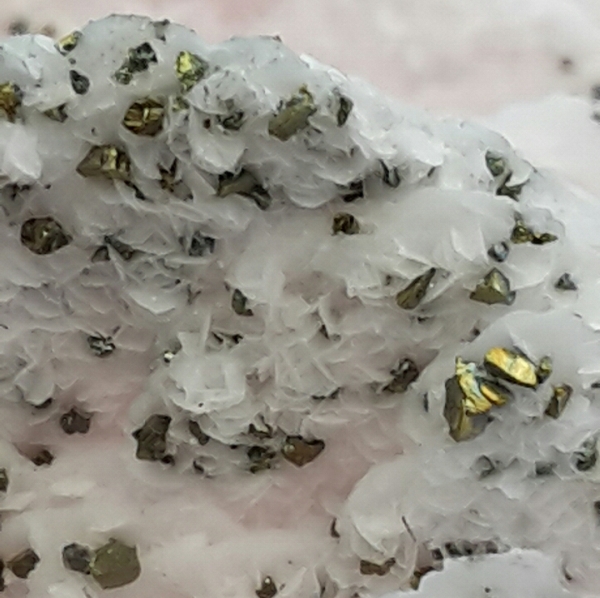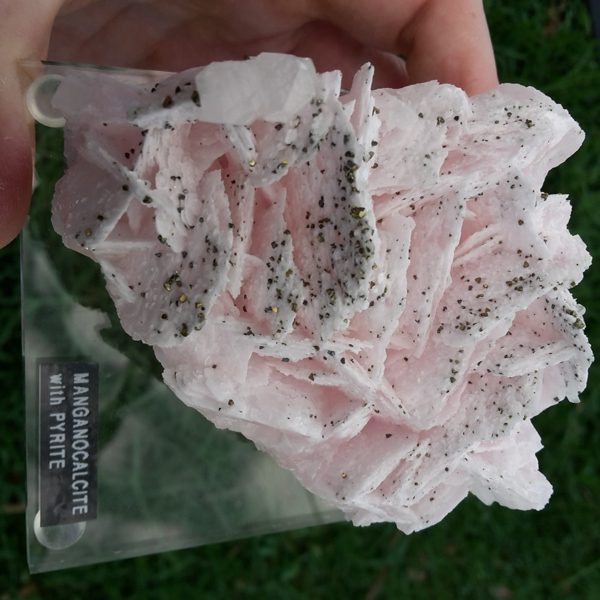No products in the cart.
Crystals, Fluorescent Specimens, Metal Specimens, Minerals of the World, Top Shelf
PYRITE MANGANO CALCITE
Availability:
Out of stock
PYRITE MANGANO CALCITE
A lovely Pyrite Mangano Calcite Cluster. This great piece is a handful and light pastel pink in colour. The crystal formation in this piece is more bladed than our usual specimens and a little rustic. Sprinkled with sparkly Pyrite. Just the kind many crystal lovers choose over more perfect collectible pieces. A super nice piece and something different from the more commonly available rose quartz. This specimen makes a great gift or treat for someone special. This specimen is mounted on a perspex pad for enhanced display.
Location:
Madan, Bulgaria.
Dimensions:
7.3cm x 6.7cm x 4.5cm, 270g.
CaCO3, Calcium Carbonate.
Compare
PYRITE MANGANO CALCITE
A lovely Pyrite Mangano Calcite Cluster. This great piece is a handful and light pastel pink in colour. The crystal formation in this piece is more bladed than our usual specimens and a little rustic. Sprinkled with sparkly Pyrite. Just the kind many crystal lovers choose over more perfect collectible pieces. A super nice piece and something different from the more commonly available rose quartz. This specimen makes a great gift or treat for someone special. This specimen is mounted on a perspex pad for enhanced display.
Location:
Madan, Bulgaria.
Dimensions:
7.3cm x 6.7cm x 4.5cm, 270g.
Mangano Calcite:
(Ca,Mn)CO3.
A calcite rich in manganese. Calcite, which gets its name from chalix the Greek word for lime, is a most amazing and yet, most common mineral. It is one of the most common minerals on the face of the Earth, comprising about 4% by weight of the Earth’s crust and is formed in many different geological environments. It is just the right amount of manganese and sometimes Lead which helps calcite fluoresce Pink.
Pyrite: FeS2.
Pyrite is the classic “Fool’s Gold”. There are other shiny brassy yellow minerals, but pyrite is by far the most common and the most often mistaken for gold. Whether it is the golden look or something else, pyrite is a favorite among rock collectors. It can have a beautiful luster and interesting crystals. It is so common in the earth’s crust that it is found in almost every possible environment, hence it has a vast number of forms and varieties.
Bravoite is the name given to a nickel-rich iron sulfide. It is closely related to pyrite but contains up to 20% nickel. Some mineral books treat it as a variety of pyrite. Pyrite is a polymorph of marcasite, which means that it has the same chemistry, FeS2, as marcasite; but a different structure and therefore different symmetry and crystal shapes. Pyrite is difficult to distinguish from marcasite when a lack of clear indicators exists.
STRUCTURE
Pyrite’s structure is analogous to galena’s structure with a formula of PbS. Galena though has a higher symmetry. The difference between the two structures is that the single sulfur of galena is replaced by a pair of sulfurs in pyrite. The sulfur pair are covalently bonded together in essentially an elemental bond. This pair disrupts the four fold symmetry that a single atom of sulfur would have preserved and thus gives pyrite a lower symmetry than galena. We have sold the Disc form called Pyrite Sun, Spheres formed of hundreds of squares, Cubes of near square, Octahedral crystal form and crystal cluster forms.
Although pyrite is common and contains a high percentage of iron, it has never been used as a significant source of iron. Iron oxides such as hematite and magnetite, are the primary iron ores. The metal is not as economical as these ores possibly due to their tendency to form larger concentrations of more easily mined material. Pyrite would be a potential source of iron if these ores should become scarce.
SKU: H0204 Categories: Crystals, Fluorescent Specimens, Metal Specimens, Minerals of the World, Top Shelf Tags: Mangano Calcite, pyrite, PYRITE MANGANO CALCITE
You may also like…
- Galena, Metal Specimens, Minerals of the World, Pyrite
CHALCOPYRITE GALENA SPHALERITE
CHALCOPYRITE GALENA SPHALERITE
An unusual cluster with Chalcopyrite Galena Sphalerite all in one! A classic mineral combo from Madan of three important ores. The matrix is a mix of galena and sphalerite with cubic chalcopyrite crystals on top. Several of the chalco crystals on the specimen are multicoloured, giving the whole piece an otherworldly appearance. A great addition to a metals collection for the formation and location.
Location:
Krushev dol Mine, Madan, BulgariaDimensions:
11cm x 7cm x 3cm, 439gSKU: MW7853 - Crystals, Fluorescent Specimens, Minerals of the World
MANGANO CALCITE CRYSTALS
A quality Mangano Calcite Crystals specimen. Featuring beautiful crystals that are extremely fluorescent under long wave UV light. What a stunner, this specimen is a lovely pink in daylight and neon pink fluorescing under UV light. If you only need one piece of this mineral, this would be an excellent choice. Step your collection up a level with this super Bulgarian crystal. This specimen shows BIP Brief Intense Phosphorescence with a UVA laser.
Super collectable for your crystal, mineral, calcite or fluorescent specimen collection. This beautiful small cluster would make a knockout gift. The very pink photos were taken under UVA light, peachy coloured pics with filtered UVA light and the other photos with UVC and indoor light.
Dimensions:
11.8cm x 11cm x 5.8cm, 720g.Location:
Madan, Bulgaria.Mangano Calcite:
(Ca,Mn)CO3.SKU: B3605 - Fluorescent Specimens, Metal Specimens, Minerals of the World
CHRISTMAS TREE ROCK
CHRISTMAS TREE ROCK
A specimen of Willemite, Calcite and Franklinite sometimes called the Christmas Tree Rock. This rare special specimen is short wave and long wave fluorescent. Known as the Christmas Tree rock for its bright green and red fluorescence. The dark grey metal shown in the natural light photos is Zinc ore Franklinite. The red mineral is Mangano Calcite which in this case shows BIP Brief Intense Phosphorescence. Pics taken with shortwave, longwave, and sunlight. Short Wave UV lights sold separately.
Location:
Sterling Hill Mine, Franklin, NJ, USA.Dimensions:
9.7cm x 5.3cm x 2.8cm, 183g.Willemite:
Zn2Sio4, Zinc Silicate.Franklinite:
Zn2+Fe23+O4, Zinc Iron Manganese Oxide.Calcite:
CaCO3, Calcium Carbonate.SKU: H1202 - Crystals, Fluorescent Specimens, Minerals of the World, Top Shelf
MANGANO CALCITE CRYSTAL CLUSTER
MANGANO CALCITE CRYSTAL CLUSTER
A top quality gemmy Mangano Calcite Crystal Cluster. Featuring beautiful, perfect crystals that are extremely fluorescent under long wave UV light. What a stunner, this specimen is a lovely pink in daylight and neon pink fluorescing under UV light. If you only need one piece of this mineral, this would be an excellent choice. Step your collection up a level with this super Bulgarian crystal.
This is a rare quality calcite crystal specimen. We handle a lot of this popular mineral and this is the absolute best quality we have seen, only a few specimens of this grade are available to buy, so snap one up now! Super collectable for your crystal, mineral, calcite or fluorescent specimen collection. This beautiful cluster would make a knockout gift. The very pink photos were taken under UVA light, peachy coloured pics with filtered UVA light and the other photos outside in the sun and shade.
Location:
Androvo Mine, Zlatograd, Bulgaria.Dimensions:
12.9cm x 4.2cm x 3.3cm, 235g.Mangano Calcite
(Ca,Mn)CO3CaCO3
Calcium CarbonateSKU: HXXXX - Crystals, Metal Specimens, Minerals of the World, Pyrite
CHALCOPYRITE CRYSTAL
A beautiful Chalcopyrite Crystal Cluster on a Quartz matrix. Chalcopyrite is Pyrite with Copper which gives it a more realistic look of gold. A great chunky specimen which has taken millions of years for nature to produce. The specimen is mounted on a perspex pad for enhanced display.
Dimensions:
6.6cm x 3.9cm x 5cm, 145g.Location:
Madan, Bulgaria.Chalcopyrite: CuFeS2.
SKU: MW8192
Related products
- Crystals, Metal Specimens
ELEMENT 83 BISMUTH Bi 27
Element 83 Bismuth Bi Crystal Clusters. This is top quality material. Displaying the full rainbow of colours in the sought after hopper crystal shapes. Bismuth Crystals appeal to everyone from kids, geology students, mineral collectors and crystal lovers. Who can blame us with the amazing stair pyramid shapes and rainbow of colours it displays. This mineral whether in its natural native form or in this type has some truly amazing properties that puts it in a class of its own. My photos don’t do this Bismuth justice.
Dimensions:
45g.BISMUTH Bi
SKU: C1127 - Crystals, Galena, Metal Specimens, Minerals of the World, Pyrite
GALENA SPHALERITE CRYSTALS
GALENA SPHALERITE CRYSTALS
An interesting little specimen of Galena Sphalerite Crystals. The Galena appears in perfect crystal form, a triangle look for a cubic form element. Add great looking Sphalerite Crystals for a super piece! Recognisably Bulgarian in form and association.
Dimensions:
4.3cm x 1.9cm x 3.1cm, 43g.Location:
Madan ore fields, Bulgaria.Galena: PbS
Sphalerite: ZnS
SKU: MW7658 - Crystals, Metal Specimens, Minerals of the World, Top Shelf
CUPRITE CRYSTAL
CUPRITE CRYSTAL
An outstanding and beautiful Cuprite Crystal specimen. These are getting harder to find and this is a goodie, as you can see in the photos. The red colour shines through well and the crystals show excellent octahedral formation. You simply can’t go wrong purchasing a specimen of this quality and from this location. Cuprite crystals will always be collectible and like all metals are totally oresome.
Location:
Rubtsovskoe Mine, Western Siberian Region, Russia.Dimensions:
3cm x 3cm x 2.5cm, 50g.Cuprite: Cu2O
SKU: CUPR0517 - Crystals, Galena, Metal Specimens, Minerals of the World, Quartz
GALENA QUARTZ 2
An interesting Galena Quartz 2 combo. Shiny crystals of Galena with Quartz Crystals on matrix. Start or add to your metals collection with a specimen from a premier location. Modified crystals radiating in a fin or fan formation, miner Calcite with a sprinkling of Chalcopyrite.
Dimensions:
12.2cm x 6.6cm x 5.8cm, 548g.Location:
Madan, Bulgaria.Galena:
PbS or (Pb,Ag,As,Sb,Cu)S.Quartz: SiO2.
SKU: MW8187-1 - Metal Specimens, Meteorites
IRON METEORITE NAMIBIA
IRON METEORITE NAMIBIA
The real deal Star Dust or Space Rock, Iron Meteorite Namibia. This specimen originally came from outer space and landed in Namibia. The Gibeon meteorite shower is the 6th largest in total mass known at present. The criss cross pattern shown on the cut face is referred to as Widmanstatten Pattern and is one way of knowing that you have a real Meteorite.
Natural iron is not necessarily “native” to Earth since it rarely occurs on the Earth’s surface by terrestrial processes. It is mostly found in the form of meteorites that have impacted the Earth’s surface. A few rare terrestrial gabbros and sulfide deposits do contain elemental iron-nickel deposits, these are the only truly native iron-nickel. All natural iron, whether it is native or meteoritic, is actually an alloy of iron and nickel. The two elements are combined in varying percentages from less than 6% nickel to as much as 75% nickel, although iron is by far more common than nickel.
Location:
IVA, Gibeon, Namibia.Dimensions:
3.2cm x 2.3cm x 0.5cm, 17g.Chemistry: Fe-Ni, Elemental Iron-nickel.
SKU: MW7876

























